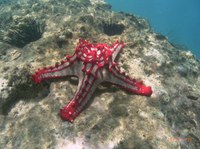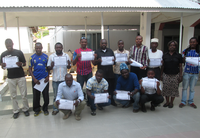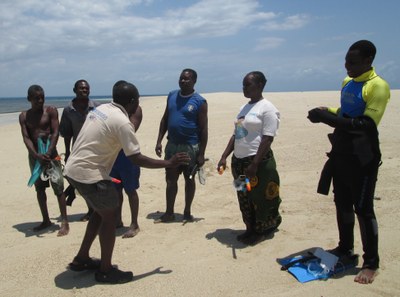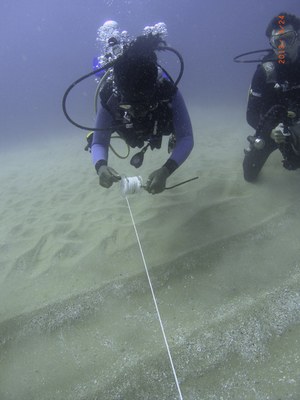The COAST Project Working to Integrate Reef and Marine Recreation Management Principles in East Africa: Case Studies from Kenya Mozambique and Tanzania
Understanding the Promise of Tourism in Africa
Tourism in coastal areas is one of the largest and fastest growing sectors of the industry that holds a promise of contributing to the econom ic and social wellbeing of the destination countries. Yet, the local residents of most popular destinations are more likely to experience the uglier side of tourism trade than any real promise of tantalising riches. In essence, communities have to contend with negative impacts such as rising pollution and degradation of sensitive marine and coastal areas from poorly planned developments, competition for fresh water and over-exploitation of scarce resources to feed the tourism industry, rising real estate prices, displacement of local fishing and farming communities, and irreversible damage to local culture. The good news is that there is a growing recognition that not all forms of tourism are equal and that tourism can be managed to deliver both quality visitor experiences and benefits to local environment and biodiversity, economies and livelihoods rather than simply draw in large volumes of visitors.
ic and social wellbeing of the destination countries. Yet, the local residents of most popular destinations are more likely to experience the uglier side of tourism trade than any real promise of tantalising riches. In essence, communities have to contend with negative impacts such as rising pollution and degradation of sensitive marine and coastal areas from poorly planned developments, competition for fresh water and over-exploitation of scarce resources to feed the tourism industry, rising real estate prices, displacement of local fishing and farming communities, and irreversible damage to local culture. The good news is that there is a growing recognition that not all forms of tourism are equal and that tourism can be managed to deliver both quality visitor experiences and benefits to local environment and biodiversity, economies and livelihoods rather than simply draw in large volumes of visitors.
The COAST Project Working to Maximize the Value of Marine Ecosystems
In recognition of these challenges, the COAST Project is working to apply, through a series of practical demonstration projects in different thematic areas, a number of Best Available Practices and/or Best Available Technologies (BAPs/BATs) within selected coastal tourism destinations in Sub Saharan Africa. These demonstration projects are all aimed to contribute to the reduction of negative environmental impacts resulting from land based, tourism sector actions and pollutants. To achieve this in the Reef and Marine Recreation Management Thematic Area, EcoAfrica are the UNIDO sub-contracted leader working across three countries (Kenya, Mozambique and Tanzania). The RMRM work focuses on reef surveys and GIS mapping of sensitive areas and damaged sites within the demonstration sites and includes management planning, awareness creation and capacity building on reef management and conservation to reduce pollution, loss of biodiversity and other negative impacts to the reef and marine areas.
All this is in recognition to the fact that sensitive marine and coastal ecosystems, specifically coral reefs, sea grasses and mangroves, are highly productive and provide significant economic goods and services. These include coastal storm protection, carbon sequestration, and feeding and breeding habitats for a great diversity of marine organisms including commercially important fish species. They also host a growing number of visitors and recreational activities with some of the main recreational attractions provided by marine ecosystems including glass-bottom-boat viewing, snorkelling, recreational and sport fishing and SCUBA diving. Assessments of the economic benefits generated from such activities are estimated at over $9 billion[1]globally. The question remains as to how much of this value translates into direct benefits to local communities, whose livelihood depends on these resources.
What does the Reef and Marine Recreation Management Thematic Area Seek to Achieve?
 Within the broader COAST Project implementation framework, the objective of the Reef and Marine Thematic Area is to develop and test responsible management of reef and marine recreation through the promotion and testing of sustainable tourism Best Available Practices/Technologies (BAPs/BATs) at selected sites. This includes the documentation and dissemination of the results achieved.
Within the broader COAST Project implementation framework, the objective of the Reef and Marine Thematic Area is to develop and test responsible management of reef and marine recreation through the promotion and testing of sustainable tourism Best Available Practices/Technologies (BAPs/BATs) at selected sites. This includes the documentation and dissemination of the results achieved.
This is done through:
- Raising awareness on the conservation values and issues facing the sustainable management of East African marine and reef assets among all users groups;
- Working with local stakeholders to design and develop sustainable marine recreation and conservation practices and technologies;
- Supporting capacity building and skills enhancement relating to marine recreation management in the priority areas;
- Studying and testing on a micro scale, the possibilities of livelihood diversification for local coastal residents through participatory tourism planning; and
- Basing all of the above micro scale interventions on the best available scientific knowledge of the natural resource asset base.
The COAST Project is focusing its RMRM work in three demonstration sites in the East African region: Tofu, Barra and Tofinho (Mozambique), Bagamoyo (Tanzania) and Watamu (Kenya). All these areas have since project inception been taken through intensive reef assessments, GIS mapping, capacity building and awareness creation. While all these sites are in the Western Indian Ocean region, it is important to note each site experiences different tourism-related realities and issues, as summarised below;

|
Tofu, Barra and Tofinho Demo Site in Mozambique
Figure 4:Fishing activities in Inhambane Demo Site, Mozambique The Demo site of Tofo, Barra and Tofinho (TBT), is located about 15 KMs from the historic town of Inhambane. Tofo has grown from a small coastal fishing village into a significant tourism destination. The wide sandy beaches, coral reefs, mangroves and extensive lagoon system provide a strong draw card and sustenance for growing local communities. Marine tourist attractions are largely based on the accessibility of large charismatic marine species (or mega fauna) and include; whale watching, SCUBA diving with manta rays over diverse coral communities and snorkelling with whale sharks and dolphins on ocean safaris. Large coastal sand dunes lining the coast provide a storm protection to inland areas. Mangrove forests and sea grass beds flourish at the Ponta da Barra and inside Inhambane Bay. Recent research in the Inhambane Bay confirms it to be an essential feeding and breeding habitat for a great diversity of species ranging from sea grasses to seahorses and the endangered dugongs. Apart from tourism, the main livelihood of people in the area is artisanal fishing and subsistence agriculture. Despite this natural wealth, approximately 80% of the population lives in extreme poverty[2]. With an extensive tropical coastline that is abundant with a rich natural and cultural heritage, Mozambique displays significant tourism development potential. The marine environment in the TBT area is however, threatened by destructive and excessive fishing, coastal development and pollution. The tourism industry is one of the major employers for the local people and threats to its long-term sustainability are a serious concern to the locals, the private sector and government alike. |
Bagamoyo Demo Site in Tanzania
|
Figure 5: Reef assessment in Bagamoyo demo Site Tanzania’s coastal zone harbours a rich abundance of natural and cultural resources. Once a centre for the East African Slave Trade, Bagamoyo is the oldest town in Tanzania and a cultural historical ‘hot spot’. Bagamoyo District was recently nominated as Tanzania’s seventh World Heritage Site. The Bagamoyo coastline is characterised by important marine habitats including sandy or muddy tidal flats, mangroves, coral reefs, sea grass beds, and a productive estuarine system. These ecosystems play a major role in supporting local people, providing a source of food, income and energy in the form of firewood. The Bagamoyo marine area falls within the Zanzibar channel. A number of reefs are located offshore of Bagamoyo, the largest and furthest away being Mwamba Kuni located 10 km offshore. Four of the near shore reefs were closed to fishing through a collaborative Fisheries Management Plan adopted by the surrounding villages and the District in 2006. Constant pressure on the reefs has however, led to declining fisheries in the area. Bagamoyo currently provides a business-based tourism destination with the majority of visitors travelling from Dar es Salaam for meetings and conferences. The town also attracts short-term visitors from East Africa. The tourism industry is mainly land-based while marine recreation (snorkelling) is undertaken through largely ad-hoc arrangements with fisher people. SCUBA diving and safety equipment for marine tours is currently inaccessible. While infrequent visits reportedly sometimes take place to near shore reefs, the most popular snorkelling reef is Mwamba Kuni. |
|
Watamu Demo Site in Kenya
Watamu, an acknowledged biosphere reserve, is located North of Mombasa within the Kilifi County of Kenya. Notable physical features of this demo site are rock platforms, cliffs and sandy beaches, coral reefs and sea-grass beds. Mida Creek, an enclosed Bay area that comprises tidal mud flats with fringing mangrove swamps provides an important habitat and location for recreation and fishing. This region is one of the main marine recreational centres of Kenya. Major attractions in the area are; boat trips, water sports, SCUBA diving, sport fishing and snorkelling. The Demo Site falls within a complex of protected areas known as the Malindi Watamu Marine Conservation Area (MWMCA). Here, the Malindi and Watamu Marine National Parks are encompassed within the Watamu Malindi Marine National Reserve. The key socio-economic activity within Watamu is tourism and is dependent on the beach and marine resource attractions. Tourism numbers are relatively high compared to the other two Demo Sites and the numerous hotels, guesthouses and lodges feed the associated beach trade and marine recreation activities. The majority of tourists come from Europe and Italy in particular. Artisanal fishing is another important economic activity of the MWMCA residents. Controlled fishing is permitted in the MWMCA Reserve but prohibited in the Marine National Parks, which are no-take zones. The high-density tourism development has led to increasingly restricted public access to recreational beaches. Other threats relating to marine recreation include the heavy exploitation of corals and shells for souvenirs, coral damage from trampling, boat anchorage and pollution. Coral conditions in some reef areas in Watamu are considered poor due to a high cover of turf and micro-algae. Erosion and increasing nutrients in the reef area from the neighbouring Mida Creek due to deforestation of the mangrove forests is also evident. |
Emerging Results and Lessons: Opportunities for Positive Change through the COAST Project Work
As a result of COAST Project interventions in the three countries, a number of opportunities have emerged through the RMRM activities for practical improvement of management of reef and marine recreation in each of the Demo Sites. Some of these include:
- Stronger collaboration among decision-makers, and between government, local communities, researchers, the private sector and other user groups, to ensure more informed decision-making and improved enforcement of regulations governing coastal development and marine use.
- Stronger community involvement in planning and management of marine areas and resources to ensure that their voices are heard and that pressure on the marine environment is reduced through strengthening local benefits from the tourism sector.
- Greater awareness of the uniqueness, value and sensitivity of the ecosystems upon which the tourism industry is based through greater access to information within the Demo Site, particularly to visitors, decision makers and other user groups.
- Improved networking and collaboration among the private sector operators to self-regulate activities and assume more responsibility for ensuring that visitors behave responsibly.
- Enhanced support to the local fishing communities to undertake sustainable fishing methods and enhance benefits more directly from tourism. This includes linking more with the private sector to improve conservation and management of marine and coastal resources.
- Improved capacity building of tour guides on aspects of marine recreation to ensure safe and sustainable marine recreation activities.
- Enhanced sensitization and awareness creation of existing policies and legislation governing the coastal and marine resource targeting the key resource users.
- Harmonization of institutional roles and responsibilities to clarify roles and responsibilities in terms of governance of the marine resources.
- Improved monitoring of ecosystems at the most popular/ most heavily used tourist sites and use of the information to address the threats facing these sensitive areas.
The Bigger Picture: Towards Improved Reef Management and Recreation for Sustainable Coastal Tourism in Africa
While one could argue that the inherent value of marine natural ecosystems and organisms should be enough to justify their protection, the reality, especially on the coastlines of East Africa, is that there are many competing and sometimes conflicting uses of marine resources and ecosystems. This continues to pose numerous challenges to managers who need to balance the competing uses and the needs of the different user groups within natural parameters required for healthy functioning ecosystems. Consideration of the values of sensitive marine ecosystems in management decisions also helps to ensure that some of the benefits from tourism contribute to the economic well-being of impoverished coastal communities.
For a highly extractive industry such as tourism to be socially, economically and environmentally sustainable, the industry needs to respond to the needs and aspirations and sensitivities of the local realities. The placement of local coastal communities central to future planning and management is critical to any efforts to improve the management of marine resources. It is absolutely clear that if tourism in coastal areas in the region is to be sustainable over the long-term, maintaining healthy marine ecosystems is critical and a change of mind-set amongst tourism operators and approach towards greater collaboration and sharing of benefits with local residents is essential. Increased responsibility by the tourism industry players through self-regulation and collaboration is key, especially in areas with a weak legal framework, a lack of adequate information for decision-making or weak monitoring and compliance of existing laws.

Figure 6: COAST Project guide training
FURTHER READING
|
http://www.ecoafrica.co.za/ |
|
Conservation International. 2008. Economic Values of Coral Reefs, Mangroves, and Seagrasses: A Global Compilation. Center for Applied Biodiversity Science, Conservation International, Arlington, VA, USA. |
|
O’Malley MP, Lee-Brooks K, Medd HB (2013) The Global Economic Impact of Manta Ray Watching Tourism. PLoS ONE 8(5): e65051. doi:10.1371/journal.pone.0065051 |
|
2) INE, 2009. National Institute of Statistics. Internet material: Accessed APRIL 2013. |
[1] Conservation International. 2008. Economic Values of Coral Reefs, Mangroves, and Seagrasses: A Global Compilation. Center for Applied Biodiversity Science, Conservation International, Arlington, VA, USA.
[2] INE, 2009. National Institute of Statistics. Internet material: Accessed APRIL 2013.




















